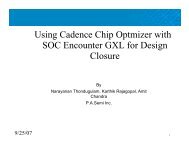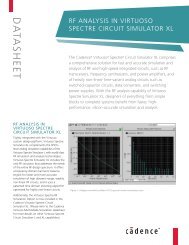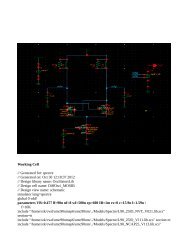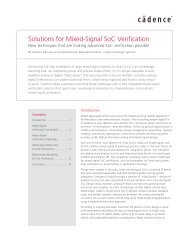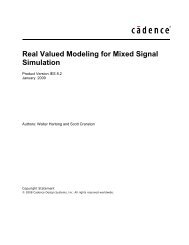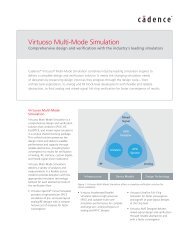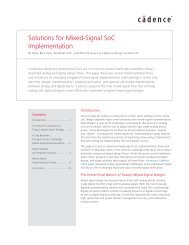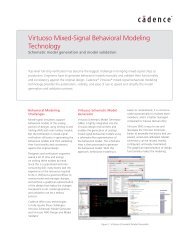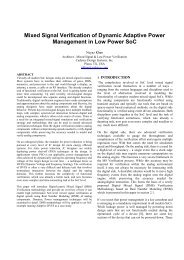Affirma Spectre DC Device Matching Analysis Tutorial - Cadence ...
Affirma Spectre DC Device Matching Analysis Tutorial - Cadence ...
Affirma Spectre DC Device Matching Analysis Tutorial - Cadence ...
You also want an ePaper? Increase the reach of your titles
YUMPU automatically turns print PDFs into web optimized ePapers that Google loves.
<strong>Affirma</strong> <strong>Spectre</strong> <strong>DC</strong> <strong>Device</strong> <strong>Matching</strong> <strong>Analysis</strong> <strong>Tutorial</strong><br />
generating 200 samples using the above parameters ...<br />
fitted parameter 0 = 0.0102933<br />
fitted parameter 1 = 0.00290799<br />
fitted parameter 2 = 0<br />
The program is by no means to be robust or efficient. Nevertheless, it illustrates the<br />
concept of curve fitting. The exact procedure for fitting your measurements to obtain<br />
proper model parameters robustly has to be developed by your modeling group.<br />
#include <br />
#include <br />
#include <br />
#define F77CONV(array,i,j,lda) (array[ (i) + (lda) * (j) ])<br />
main() {<br />
int i, j, k, samples, n, lda, one, zero;<br />
double y, sigmavth2; /* sigma^2(dvth) */<br />
double mvtwl, mvtwl2, mvt0;<br />
double w, l;<br />
double r, t, rcond, tmp;<br />
double alpha[3][3], rhs[3], work[3];<br />
double farray[9];<br />
int ipvt[3];<br />
double drand_();<br />
/* the following are the model parameters to fit */<br />
Release Date Back Page 22<br />
Close<br />
22






